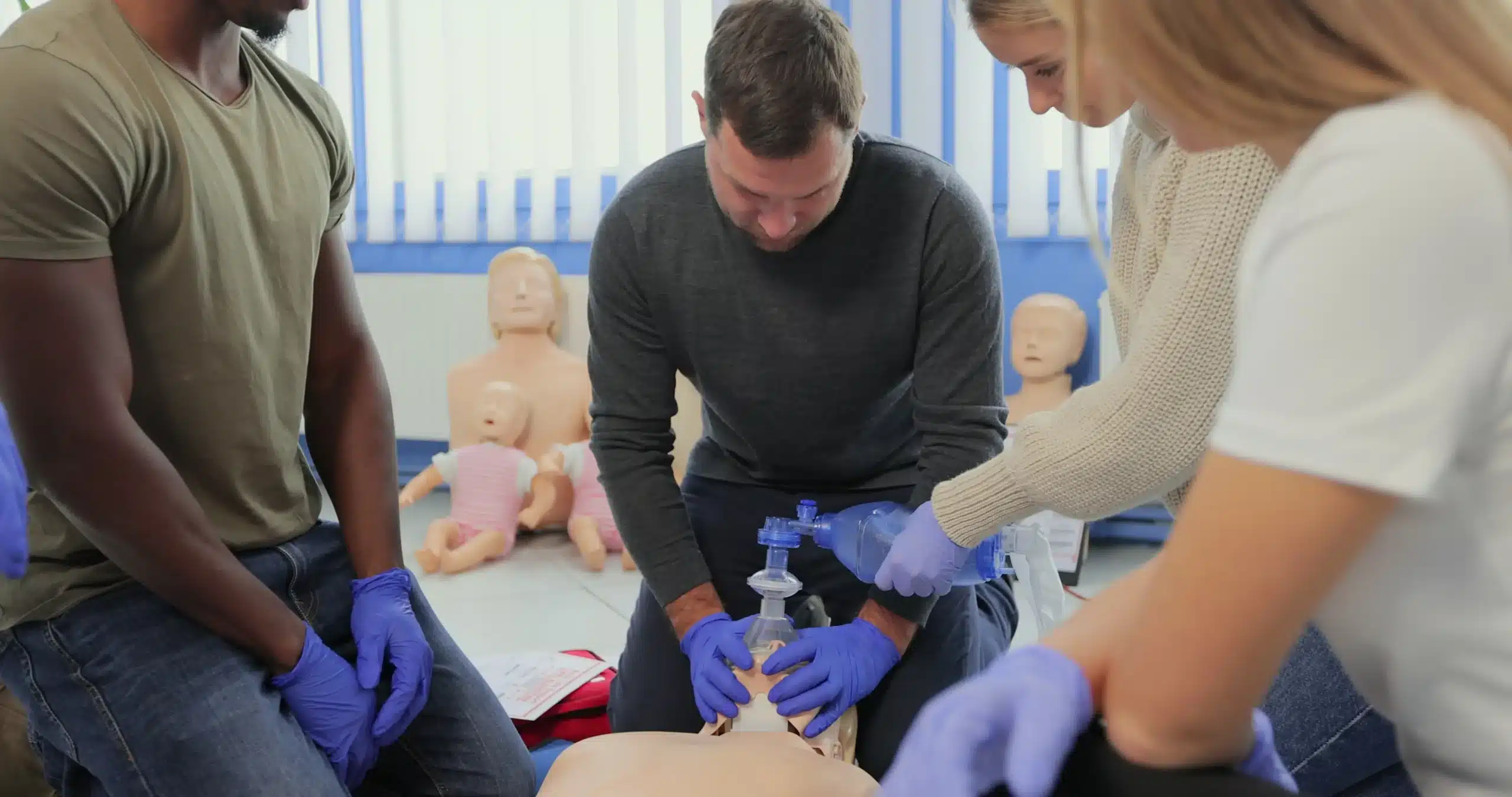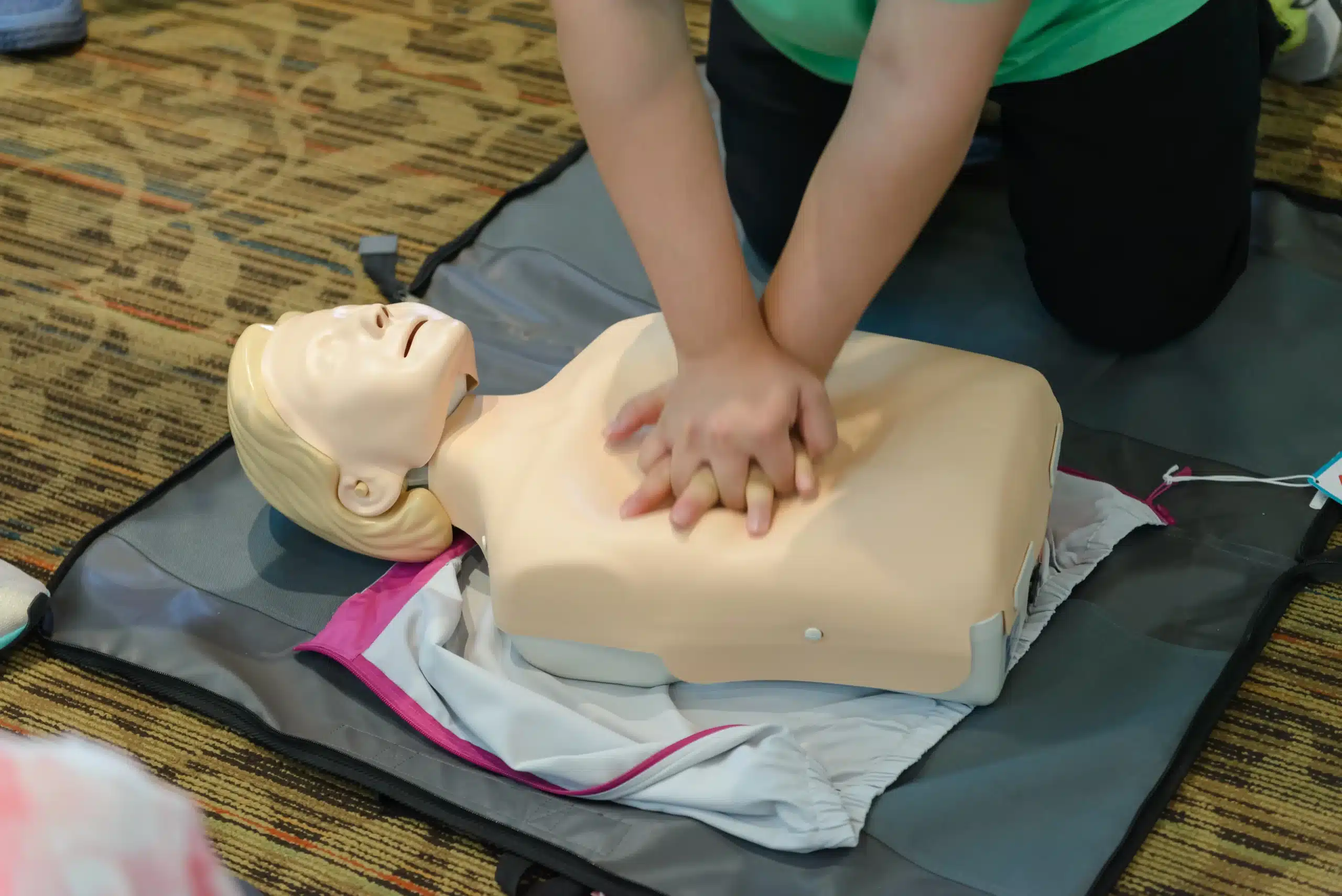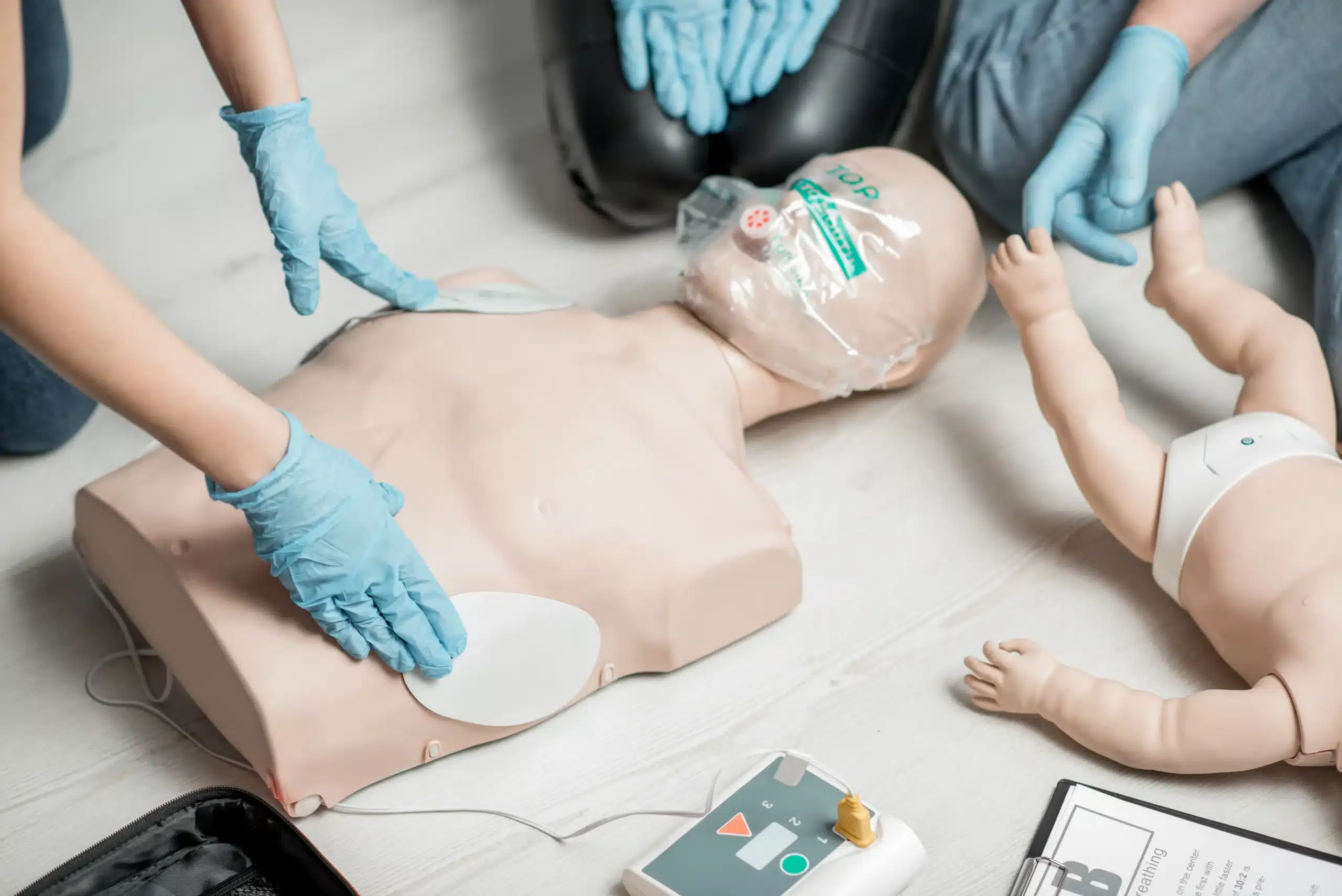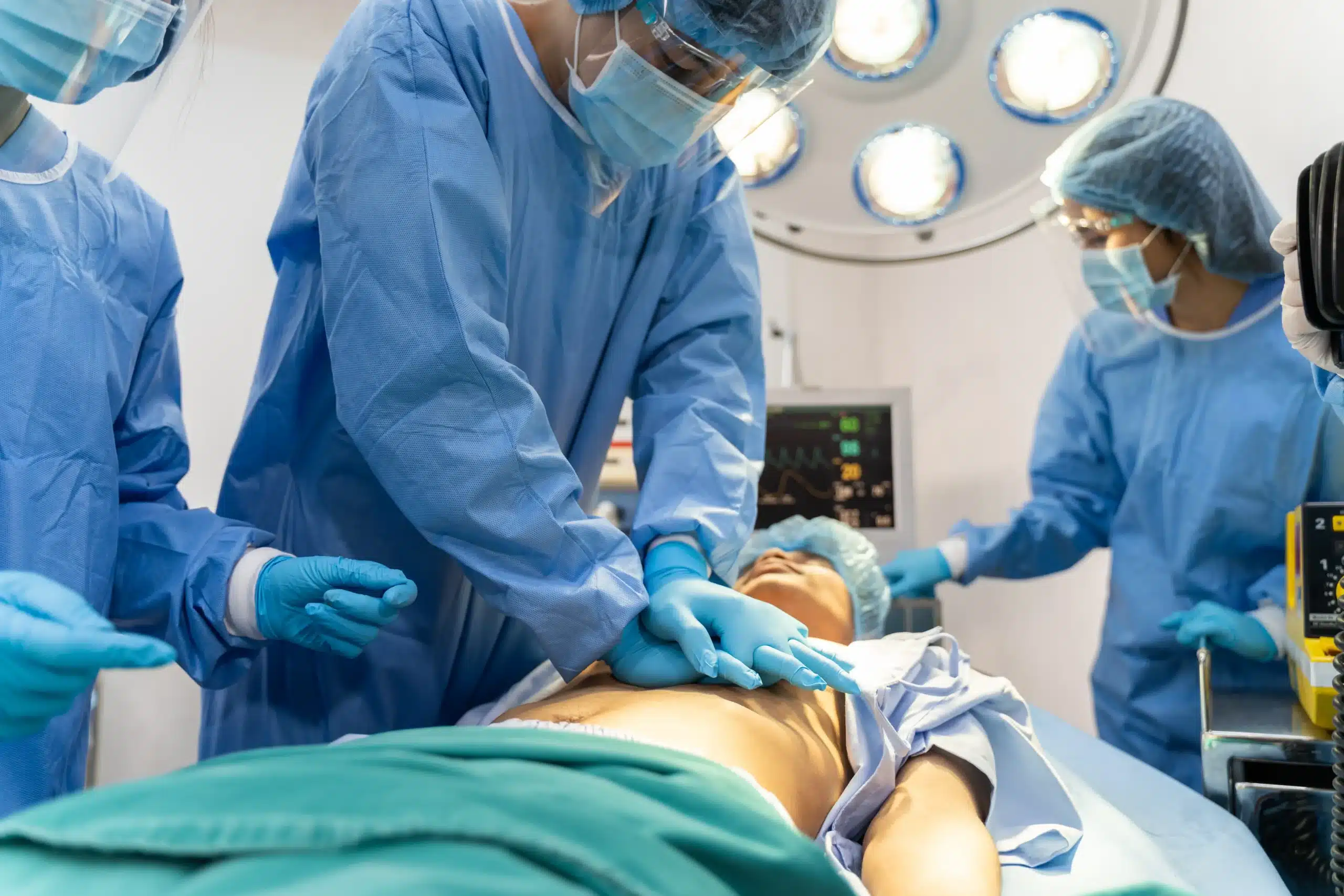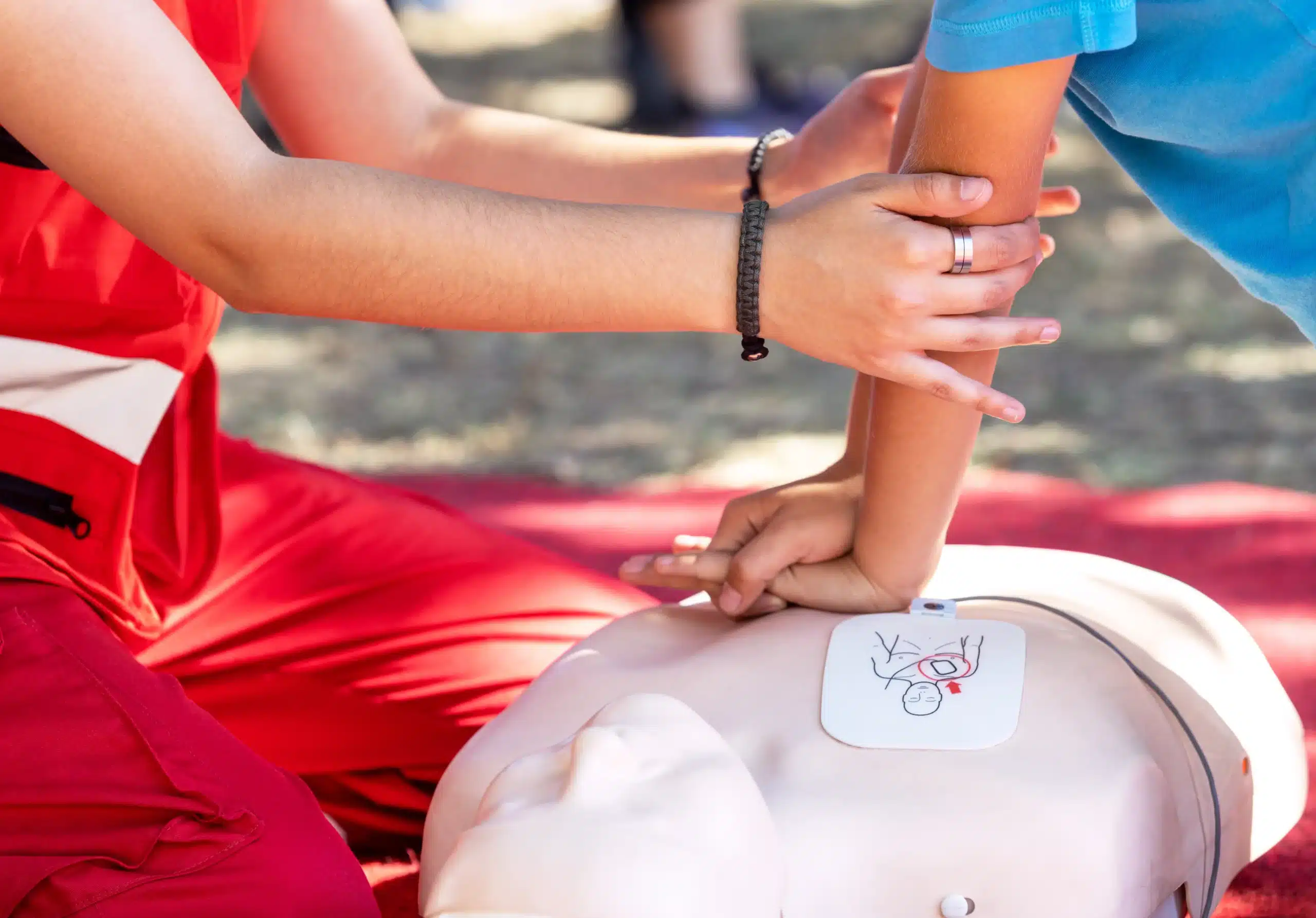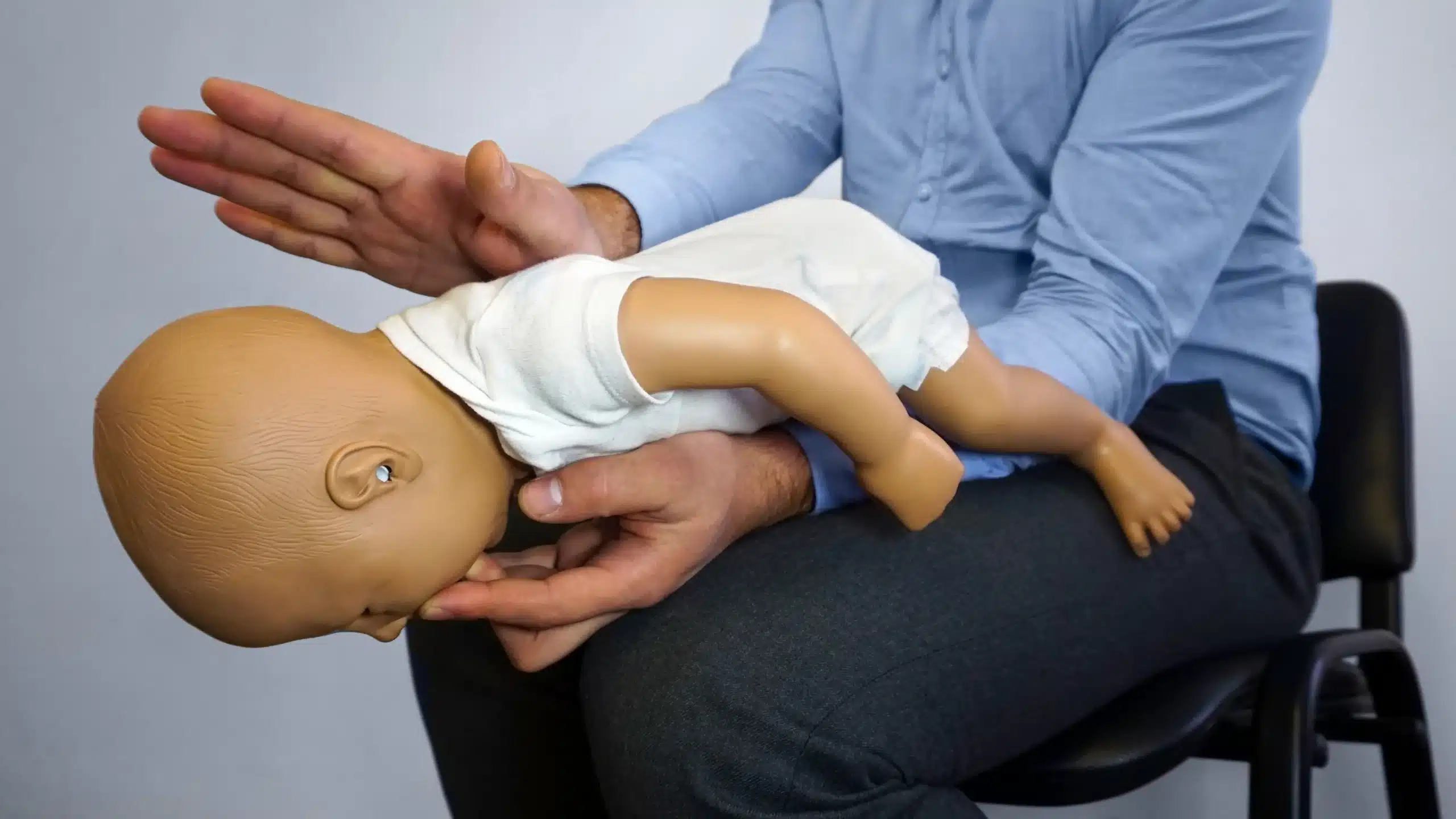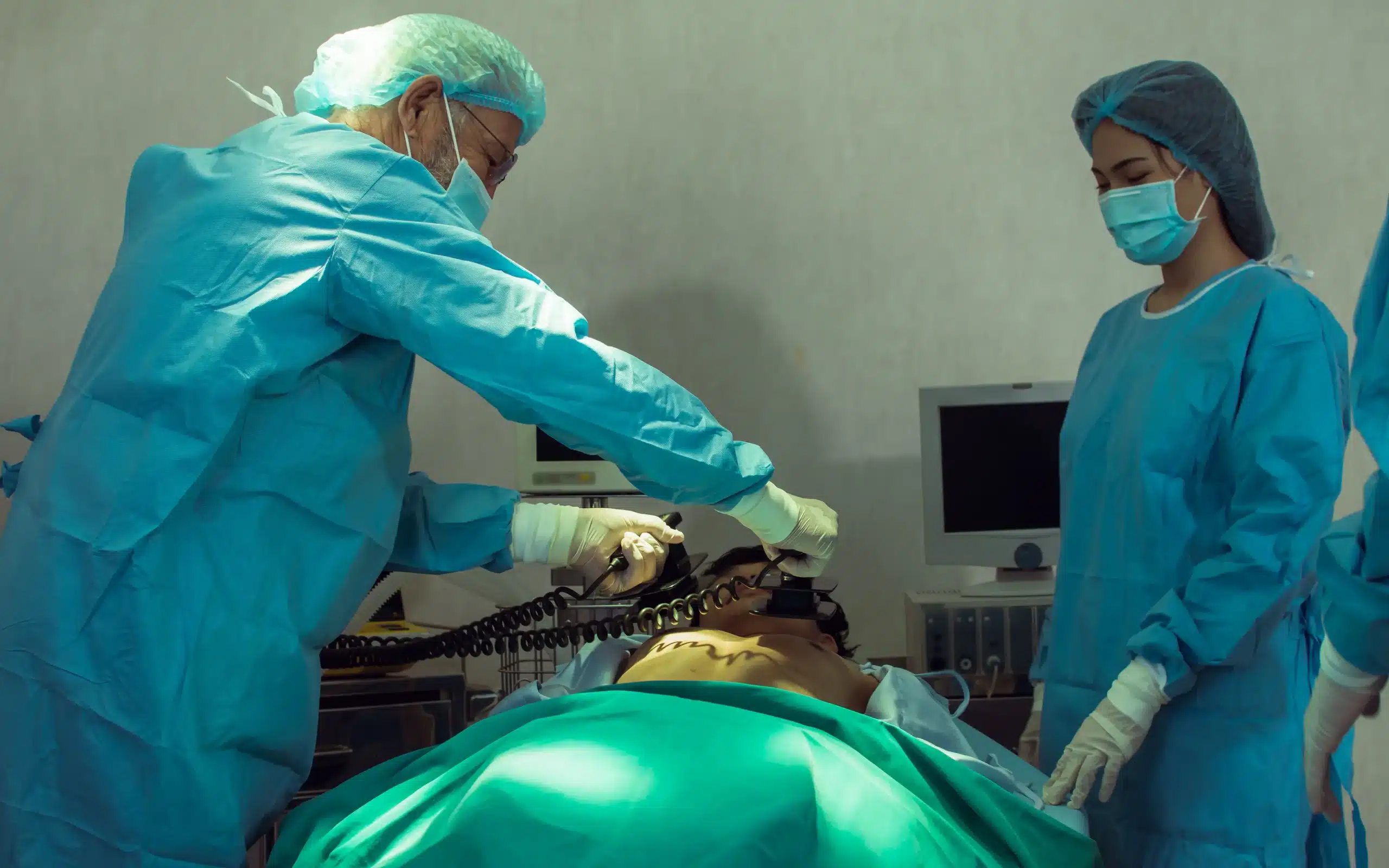In a medical emergency, every second counts. CPR can double or even triple a person’s chances of survival, making it a crucial skill for everyone to learn. If you’ve been searching for “CPR courses near me,” this guide will provide you with all the information you need to get started. We’ll cover the different types of CPR courses available, what to expect during training, and how to choose a certified instructor. We’ll also discuss the benefits of CPR certification, how to maintain your skills, and where to find affordable training options, including those offered by Safety Training Seminars.
Key Takeaways
- CPR training empowers you to save lives: Learning CPR, whether you’re a healthcare professional or community member, equips you to respond effectively during emergencies and significantly improves survival rates.
- Select the right CPR course for your needs: Consider factors like the course content (adult, child, infant CPR), certification type (AHA, Red Cross), and training format (online, in-person, or blended) when choosing a course. Contacting providers directly can help you find the best fit.
- Maintain your CPR skills through practice and continuing education: Regularly practicing CPR techniques, renewing your certification every two years, and pursuing additional educational opportunities will ensure you’re always prepared and confident in your ability to provide assistance.
What is CPR and Why is it Important?
Cardiopulmonary resuscitation (CPR) is a lifesaving technique used in emergencies when someone’s heartbeat or breathing has stopped. It involves chest compressions and, sometimes, rescue breaths. These actions maintain blood flow and oxygen to the brain and other vital organs until professional medical help arrives. CPR can truly be the bridge between life and death in these critical situations.
Learning CPR empowers you to take immediate action during medical emergencies. The American Heart Association (AHA) emphasizes how effective CPR can double or even triple a person’s chances of survival after cardiac arrest. Immediate intervention is critical, as brain damage can occur within minutes without oxygen. Every second counts, and knowing CPR equips you to make a real difference. CPR classes, like those offered by Safety Training Seminars, provide the skills and confidence to respond effectively.
CPR training isn’t just for healthcare professionals; it’s a valuable skill for everyone. Community CPR programs offer accessible training courses that cover CPR, AED use, and first aid. These programs are designed for both lay rescuers and community members, ensuring that anyone can learn CPR and be prepared to help in an emergency. Think of it as a vital life skill, much like knowing how to swim or change a tire—it’s something that can empower you to handle unexpected situations. Knowing CPR can make you a valuable asset in your community and workplace. It also encourages a culture of preparedness and can inspire others to learn this lifesaving skill.
CPR Course Options
Choosing the right CPR course depends on your specific needs and goals. Whether you’re a parent, a healthcare provider, or simply want to be prepared for emergencies, understanding the different options available will help you make the best decision. Safety Training Seminars offers a variety of courses to meet diverse needs, and our low price guarantee ensures you’re getting the best value.
Adult CPR
Learning adult CPR is a vital skill that can quite literally save a life. Effective CPR can double or even triple a person’s chances of survival after cardiac arrest. This course teaches you how to recognize the signs of a cardiac event, perform chest compressions, and provide rescue breaths. It empowers you to respond confidently in emergencies and potentially make a profound difference. Check our BLS courses in Visalia to find a class that fits your schedule.
Child and Infant CPR
While adult CPR is crucial, knowing how to respond to emergencies involving children and infants requires specialized training. Child and infant CPR courses cover the techniques specific to these age groups, addressing their unique physiological differences. These courses often include training on choking rescue, providing a comprehensive approach to pediatric emergencies. CPR and First Aid training for childcare providers is essential in California, and we offer courses designed to meet these requirements.
Advanced Life Support (ACLS)
For healthcare professionals, Advanced Life Support (ACLS) training goes beyond the basics of CPR. ACLS certification covers advanced airway management, pharmacology, and team dynamics in emergency situations. It’s a critical skill set for doctors, nurses, paramedics, and other healthcare providers who manage complex cardiac emergencies. Our ACLS courses provide comprehensive training and certification to ensure you’re prepared to deliver the highest level of care. You can also explore our RQI classes for specialized resuscitation training. If you have questions or want to learn more about our course offerings, feel free to contact us.
Finding CPR Courses Near You
Ready to learn CPR? Finding the right course near you doesn’t have to be a challenge. Here are a few ways to locate CPR training options:
Search Online
The internet is a powerful tool for finding CPR classes. A quick search for “CPR classes near me” will likely yield several results. The American Red Cross, for example, has a user-friendly website where you can locate CPR training in a variety of formats. Many local organizations also have websites listing course schedules and registration information. Our website, for example, lists all of our upcoming BLS courses in Visalia.
Check with Healthcare Providers
Local hospitals, clinics, and healthcare providers often offer CPR training to both staff and the community. Reach out to your doctor’s office, local urgent care clinics, or even fire departments to inquire about upcoming CPR courses. You can also check with organizations like the American Heart Association for certified training centers in your area.
Explore Community Resources
Community centers, recreation departments, and even some schools offer CPR training. Check with your local community center or library for information on CPR courses. Don’t forget to explore options like churches, non-profit organizations, and local YMCA or YWCA branches, which sometimes host CPR training sessions. These community-based courses are often more affordable and accessible.
What Happens in a CPR Course?
CPR courses are designed to equip you with the life-saving skills needed to respond effectively during cardiac emergencies. They blend theory and practical exercises to ensure you’re confident and prepared. Let’s break down what you can expect during a typical CPR course.
Course Length and Certification
CPR courses vary in length depending on the type and level of certification. A basic CPR course typically lasts a few hours, while more advanced courses like ACLS or PALS may take longer. The cost usually covers training materials, instructor fees, and the certification exam itself. Basic CPR certification might cost between $50 and $150, while more advanced certifications, or those including comprehensive first aid, could cost $200 or more. Check with your chosen provider, like Safety Training Seminars, for specific pricing and course durations. Safety Training Seminars offers a low price guarantee for their courses.
Hands-on Training and Evaluation
The core of any good CPR course is hands-on training. You’ll learn the proper techniques for chest compressions, rescue breaths, and how to use an automated external defibrillator (AED). Expect to practice these skills on mannequins under the guidance of a certified instructor. This practical experience builds muscle memory and confidence, crucial for effective CPR in real-life situations. Your instructor will evaluate your technique throughout the course to ensure you’re performing CPR correctly. Effective CPR training is crucial for confident and competent responses to cardiac arrest emergencies.
Getting Certified
Upon successful completion of the course and skills evaluation, you’ll receive your CPR certification. This certification is usually valid for two years, after which you’ll need to take a refresher course to stay current. While online CPR certifications exist, make sure they’re issued by a reputable organization accredited by the American Heart Association (AHA). Acceptance of online-only CPR certifications can vary, so it’s always best to confirm requirements with your employer or organization. For reliable in-person training and certification in Visalia, Tulare, and Delano, consider contacting Safety Training Seminars to discuss your options and find the right course for your needs.
CPR Course Costs
Knowing the price range for CPR certification can help you budget and find the best value. Let’s break down typical costs, factors that influence pricing, and potential ways to save.
Typical Prices
CPR certification typically costs between $50 and $150 for basic courses. More comprehensive training, like advanced certifications or courses that include first aid, can cost $200 or more. Remember, this investment equips you with life-saving skills. Our Low Price Guarantee ensures you’re getting the best possible value for your training. We offer a range of American Heart Association courses to meet your needs.
Factors Influencing Cost
Several factors affect CPR course pricing. Course length plays a role—longer courses often cost more. The type of certification also matters. Basic CPR is typically less expensive than advanced certifications like ACLS or PALS. The training provider and any included materials (like manuals or pocket masks) can also influence the final cost. You can find our course schedule and pricing for BLS courses in Visalia on our website.
Discounts and Aid
It’s always a good idea to ask about potential discounts. Some providers offer discounts for groups, students, or organizations. If you’re concerned about the cost, explore options like payment plans or check if your employer offers assistance with training expenses. CPR and first aid training are valuable investments, and there are often ways to make them more accessible. Contact us to discuss options and find a course that fits your budget.
Choosing a CPR Provider
Finding the right CPR class is as important as learning the skills themselves. You want a program that meets your needs and provides a recognized certification. Here’s a breakdown of some well-known providers and what they offer:
American Heart Association
The American Heart Association (AHA) is a leading authority in CPR training. Their courses are widely recognized and respected, covering essential life-saving skills and knowledge. AHA certification ensures you receive high-quality training that meets industry standards. Look for classes offered through licensed training centers like Safety Training Seminars. For healthcare providers seeking certifications like BLS, ACLS, and PALS, the AHA is often the preferred choice.
Red Cross
The American Red Cross also offers a variety of CPR and first aid training programs. They emphasize the importance of CPR and its impact on survival rates during cardiac emergencies. The Red Cross is known for its comprehensive approach, preparing individuals to respond confidently in emergencies. Their programs often cater to a broader audience, including community members, workplace safety requirements, and general preparedness.
Safety Training Seminars
Safety Training Seminars focuses on providing thorough CPR and AED certification programs. They understand the importance of comprehensive training to prepare individuals for real-life emergencies. Serving Visalia, Tulare, and Delano, CA, they offer a low-price guarantee and excellent customer service. You can find their course schedule and register for BLS courses in Visalia on their website. They offer various AHA courses, including RQI classes, and maintain a commitment to providing affordable, high-quality training.
Local Options
Community outreach programs often offer CPR training, making it accessible to a wider audience. These local initiatives are a great way to learn CPR and contribute to a more prepared community. Check with your local fire department, community centers, or hospitals for available courses. You can also contact Safety Training Seminars directly to learn more about their offerings and discuss your training needs. They can help you find the right course based on your specific requirements.
Online vs. In-Person CPR Training
Choosing the right CPR training format depends on your learning style, schedule, and specific needs. Let’s break down the pros and cons of online versus in-person training to help you decide.
Pros and Cons
Online CPR training offers incredible flexibility. You can learn at your own pace and complete the coursework from anywhere with an internet connection. This makes online certification a convenient option for busy professionals, parents, and anyone with a packed schedule. However, online courses typically don’t include hands-on skill demonstrations, which are crucial for mastering CPR techniques. While you’ll learn the theory, you might miss out on the practical experience of performing compressions and rescue breaths on a manikin. It’s important to remember that online CPR certifications are valid, provided they are issued by a reputable organization accredited by the American Heart Association (AHA) or similar bodies, like the Red Cross.
In-person CPR training provides a more interactive and comprehensive learning experience. These classes usually include lectures, demonstrations, and, most importantly, hands-on practice. This allows you to develop muscle memory and gain confidence in your abilities under the guidance of a certified instructor. In-person training often meets professional licensing and OSHA requirements, making them essential for many healthcare professionals and other regulated industries. Because in-person classes through organizations like the Red Cross.
Blended Learning
Blended learning offers a happy medium, combining the flexibility of online learning with the practical application of in-person skills sessions. You can work through the online coursework at your convenience and then attend a shorter in-person session to practice your skills on a manikin and receive feedback from an instructor. This approach offers the best of both worlds, making it an appealing option for those who want a thorough understanding of CPR but need a more flexible schedule. Many organizations, including the Red Cross, offer CPR classes in blended formats, allowing you to choose the method that best suits your learning style and availability. Blended learning effectively combines online training with the essential hands-on practice of in-person sessions, offering a well-rounded approach to CPR education. You can find more information on the benefits of blended learning for CPR training from resources like CPR Certification Now.
Essential CPR Skills
CPR combines chest compressions and rescue breaths to maintain blood circulation and oxygen levels in someone experiencing cardiac arrest. Let’s break down the essential skills involved:
Effective Chest Compressions
Effective chest compressions are the cornerstone of CPR. You’ll learn the proper hand placement—center of the chest, between the nipples—and the correct depth and rate of compressions. This rhythmic pressure helps circulate blood to vital organs, buying precious time until professional help arrives. This is crucial because without oxygen, brain damage can occur within minutes. CPR can quite literally double or even triple a person’s chances of survival, so mastering this skill is paramount.
Giving Rescue Breaths
Rescue breaths deliver oxygen to the person’s lungs. During a CPR course, you’ll learn how to open the airway, create a proper seal, and deliver effective breaths. This part of CPR can feel a little intimidating at first, but practice and proper instruction will build your confidence. Training helps you stay calm and focused under pressure, enabling you to perform CPR efficiently in an emergency.
AED Use
Automated External Defibrillators (AEDs) are life-saving devices that can restore a normal heart rhythm. CPR courses often include AED training, teaching you how to assess the situation, safely operate the device, and integrate its use with CPR. Knowing how to use an AED can significantly increase the chances of survival.
Choking Rescue
CPR training often covers techniques for assisting someone who is choking. You’ll learn how to recognize the signs of choking and perform the Heimlich maneuver (or abdominal thrusts) to dislodge the obstruction. This quick action can prevent a life-threatening situation. Many community CPR programs offer courses that cover CPR, AED use, and First Aid, providing a well-rounded approach to emergency preparedness.
Benefits of CPR Certification
Getting CPR certified isn’t just about acquiring a skill; it’s about empowering yourself to make a real difference. Whether you’re a healthcare professional, a concerned parent, or simply someone who wants to be prepared, CPR certification offers a range of valuable benefits.
Save a Life
The most significant benefit of CPR certification is the potential to save someone’s life. CPR can double or even triple a person’s chances of survival after cardiac arrest. Prompt intervention is crucial, as brain damage can occur within minutes without oxygen. By knowing how to perform CPR, you can provide immediate support while waiting for professional medical help to arrive. This quick action can be the difference between life and death. Learning CPR equips you with the skills and confidence to respond effectively in such critical situations. CPR certification provides the tools and knowledge to react decisively during emergencies. For healthcare providers, CPR is an essential skill.
Career Advancement
For many healthcare professionals, CPR certification is a job requirement and a stepping stone for career growth. It demonstrates a commitment to patient care and a willingness to go the extra mile. CPR training enhances your skills in high-stress environments, enabling you to remain calm and focused during emergencies. This can be invaluable in fields like nursing, medicine, and physical therapy. Even outside of healthcare, CPR certification can make you a more valuable employee, particularly in roles involving childcare, education, or fitness. Having CPR skills on your resume can open doors to new opportunities.
Emergency Preparedness
CPR certification empowers you to be prepared for unexpected emergencies, not just in professional settings but also in your daily life. You could be at a restaurant, a sporting event, or even at home when someone experiences a medical crisis. Community outreach programs often encourage public participation in CPR training to create a network of prepared individuals within the community. Knowing CPR can give you peace of mind, knowing that you have the skills to assist loved ones, neighbors, or even strangers in need. It transforms you from a bystander into a potential lifesaver.
Maintaining Your CPR Skills
Once you’re CPR certified, staying sharp on your skills is key. Regular practice and continuing education ensure you’re always ready to respond effectively in an emergency. Let’s explore how you can maintain your CPR skills and knowledge over time.
Renewing Your Certification
CPR certifications typically expire after two years. To stay current, you’ll need to renew your certification through a refresher course. These courses cover the latest guidelines and techniques, ensuring your skills are up-to-date. Check with your certifying organization, such as the American Heart Association or the Red Cross, for renewal options. Many providers, like Safety Training Seminars, offer convenient renewal courses to fit your schedule. You can find their BLS renewal courses online.
Continuing Education
Beyond renewing your certification, ongoing education is crucial for maintaining and improving your CPR skills. The field of healthcare is constantly evolving, so staying informed about the latest research and best practices is essential. Look for opportunities to expand your knowledge through workshops, online resources, and advanced certifications. Even seasoned professionals can benefit from regular review and practice. Consider exploring additional courses, such as RQI classes, to further enhance your skills.
Practice for Retention
Consistent practice is the cornerstone of maintaining proficiency in any skill, and CPR is no exception. Regularly practicing the techniques you learned in your CPR course helps solidify your muscle memory and build confidence. You can practice with friends, family, or colleagues, or even use mannequins for realistic simulations. Hands-on practice, even without formal training, can significantly improve your response time and effectiveness in a real emergency. Remember, the more you practice, the more prepared you’ll be to act quickly and confidently when it matters most. For questions about maintaining your CPR skills or finding the right course for your needs, contact us at Safety Training Seminars. We offer a low price guarantee and are committed to providing excellent customer service. Check out our low price guarantee.
Related Articles
- Why CPR Is Crucial in Healthcare
- CPR Certification Near Me: A Complete Guide – Visalia CPR Classes
- CPR Training in Tulare: Your Guide to Certification – Visalia CPR Classes
- CPR Classes in Visalia: Find the Right One For You – Visalia CPR Classes
- BLS Certification in Walnut Creek: Your Guide – Visalia CPR Classes
Frequently Asked Questions
How often do I need to renew my CPR certification? CPR certifications are typically valid for two years. Renewal courses ensure you stay up-to-date on the latest guidelines and techniques.
What’s the difference between CPR and First Aid? CPR focuses on restoring breathing and circulation, while First Aid addresses a broader range of injuries and illnesses, like cuts, burns, and fractures. They are distinct but complementary skills. Many courses combine both CPR and First Aid training.
What if I’m nervous about performing CPR in a real emergency? It’s completely normal to feel apprehensive. High-quality CPR training emphasizes hands-on practice and builds confidence. Remember, any attempt at CPR is better than none. Your training will kick in when you need it most.
Are online CPR certifications accepted? Online CPR certifications are generally accepted if they are issued by a nationally recognized organization and include a hands-on skills assessment component. However, it’s always best to check with your employer or organization to confirm their specific requirements.
How can I find a CPR class near me? Searching online for “CPR classes near me” is a great starting point. You can also check with local hospitals, community centers, and organizations like the American Heart Association or the Red Cross. Safety Training Seminars offers various CPR courses in Visalia, Tulare, and Delano, CA.
